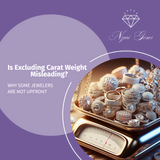Is Excluding Carat Weight Misleading?

Why Some Jewelers Are Not Upfront
Omitting carat weight in finished jewelry can be misleading, but it depends heavily on the context and how the jewelry is being marketed. Here's a quick breakdown:
When Omitting Carat Weight Is Misleading:
- The piece is marketed as fine jewelry, implying high value, but omits carat weight to hide that the stone is smaller or of lower value.
- Photos are zoomed in or staged to make the gem appear larger than it is, without any specs to clarify the true size.
- The seller emphasizes the gem's quality or price without giving measurable details like carat weight, leaving the buyer to assume more than what's there.
- The stone is large enough that a buyer would reasonably expect carat weight to be disclosed—especially for diamonds, sapphires, rubies, emeralds, tanzanite, etc.
When It's Not Necessarily Misleading:
- In fashion or costume jewelry, where stones are simulated or purely decorative, carat weight may not be relevant.
- For small accent stones (like in pavé or halo settings), where total carat weight is minor or difficult to list individually.
- If dimensions are given instead of carat weight (common for opaque stones like turquoise or opal), and that’s appropriate for the stone type.
A Good Rule of Thumb:
If carat weight could influence the buyer's decision—particularly with fine or high-value jewelry—then not disclosing it might be considered misleading.
If you're looking at a piece and the carat weight isn’t listed, it’s fair to ask. If the seller avoids answering or doesn’t have the info, that’s a potential red flag. At Nzuri Gems, we clearly state the carat weight of gems in our jewelry to ensure customer confidence.
